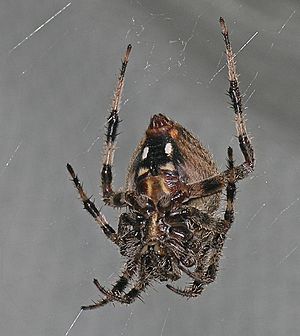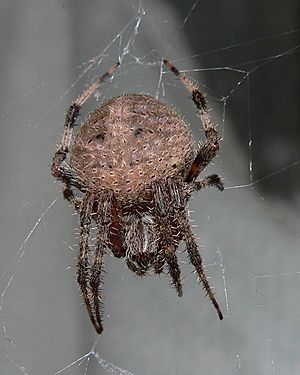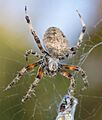Neoscona crucifera facts for kids
Quick facts for kids Neoscona crucifera |
|
|---|---|
 |
|
| Ventral view | |
 |
|
| Dorsal view | |
| Scientific classification |
Neoscona crucifera is a type of orb-weaver spider. It's part of the Araneidae family. You might know it by its common names like the Hentz orbweaver or spotted orbweaver. Some people also call it a "barn spider," but there's another spider, Araneus cavaticus, that shares that name.
Contents
About the Hentz Orbweaver
The Hentz orbweaver is a common spider. It lives across a large part of North America. You can find it from Maine to Florida in the eastern United States. It also lives in the Midwest, like Minnesota, and in the Southwest, like Arizona. This spider is also found in Mexico.
What the Hentz Orbweaver Looks Like
Hentz orbweavers come in different colors. They are often rusty-red or golden orange. The top part of their body, called the abdomen, is brown and hairy. Their legs have stripes of light and dark brown.
If you look at the underside of their abdomen, it's black. It also has two white spots. Female spiders are bigger than males. Females can be about 9.5 to 19 millimeters (0.37 to 0.75 inches) long. Males are a bit smaller.
When and Where They Live
These spiders are usually active at night. This means they are nocturnal. They build their webs and hunt when it's dark. Sometimes, in the fall, the females might be active during the day. This means they become diurnal.
You'll often see these spiders in late summer and early fall. They like to build their webs on buildings. They also build them on other things made by people. Places near outdoor lights are popular spots for their webs.
The Amazing Orb Web
The Hentz orbweaver builds a very large, round web. This type of web is called an "orb web." The main part of the web can be almost 2 feet (60 centimeters) wide! They use these big webs to catch insects.
Life Cycle and Reproduction
Female Hentz orbweavers lay their eggs in a special sac. This eggsac is made of fluffy yellow threads. It's often hidden inside a rolled-up leaf. The egg mass inside is round or shaped like a lens. It can be 5 to 12 millimeters (0.2 to 0.5 inches) across. A single eggsac can hold up to 1,000 eggs!
Young spiders, called juveniles, face dangers. They are often hunted by mud dauber wasps. These wasps catch spiders to feed their own young.
Images for kids




